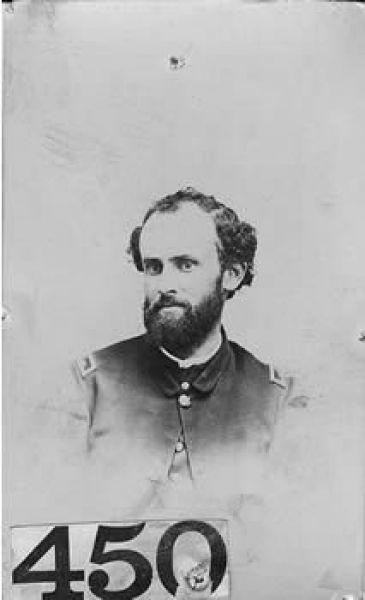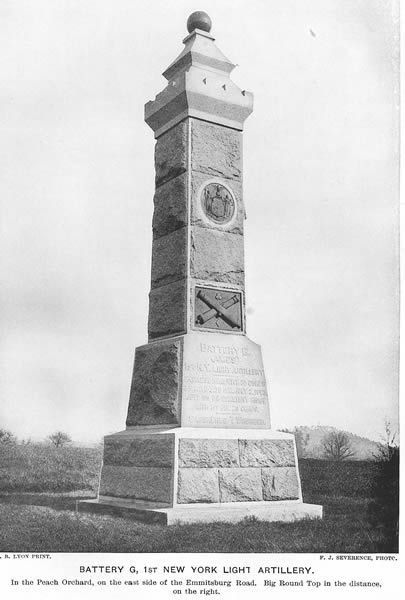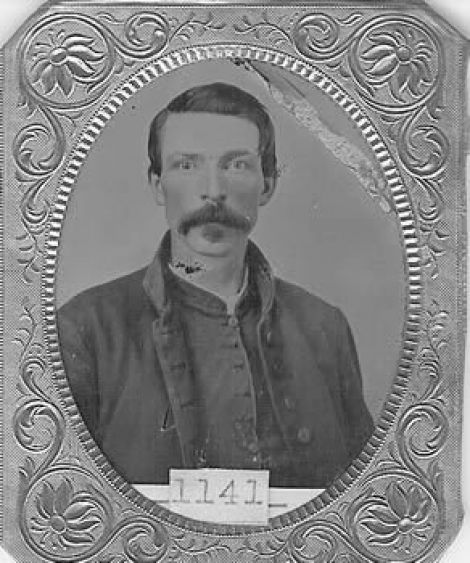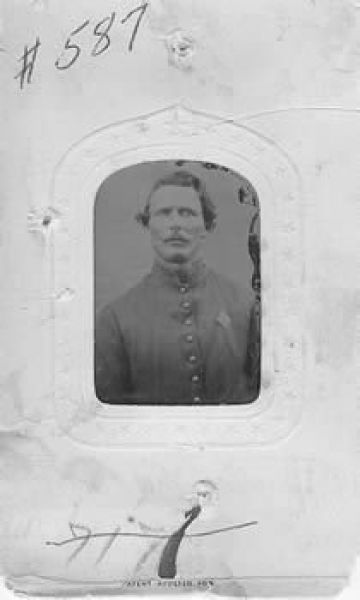Battery G, 1st Artillery Regiment (Light)
Mustered in: September 24, 1861
Mustered out: June 19,1865
THE FOLLOWING IS TAKEN FROM NEW YORK IN THE WAR OF THE REBELLION, 1ST ED. FREDERICK PHISTERER. ALBANY: J. B. LYON COMPANY, 1912.
Battery G, Capt. John D. Frank, principally recruited at Mexico, was mustered in the service of the United States September 24, 1861, at Elmira. November 12, 1861, it received by transfer members of the Chicago Light Battery C, Richard Busteed, Jr., Captain, and September 7, 1863, members of the I4th Battery. It served at and near Washington, D. C., from November, 1861; in Richardson's Division (1st), 2d Corps, Army of Potomac, from March, 1862; in the 3d Division, 2d Corps, from June, 1862; in Artillery Brigade, 2d Corps, from April, 1863; with 3d Division, 2d Corps, at Chancellorsville; in the 1st Brigade, Artillery Reserve, Army of Potomac, from May 12, 1863; in the 4th Volunteer Brigade, Artillery Reserve, Army of Potomac, from June, 1863; in the Artillery Brigade, 2d Corps, from July 12, 1863; in the Artillery Reserve, Army of Potomac, from August, 1863; in the Artillery Brigade, 2d Corps, from October, 1863; with the 2d Division, 2d Corps, in August, 1863; and in the Artillery Reserve, Army of Potomac, but attached to the 9th Corps, from January, 1865. It was honorably discharged and mustered out, under the command of Capt. Samuel A. McClellan, June 19, 1865, at Elmira.
THE FOLLOWING IS TAKEN FROM THE UNION ARMY: A HISTORY OF MILITARY AFFAIRS IN THE LOYAL STATES, 1861-65 -- RECORDS OF THE REGIMENTS IN THE UNION ARMY -- CYCLOPEDIA OF BATTLES -- MEMOIRS OF COMMANDERS AND SOLDIERS, VOLUME II: NEW YORK, MARYLAND, WEST VIRGINIA AND OHIO. MADISON, WI: FEDERAL PUB. CO., 1908.
Battery G, Capt. John D. Frank, recruited at Mexico, was mustered into the U. S. service on Sept. 24, 1861, at Elmira. It received by transfer in Nov., 1861, some of Capt. Busteed's Chicago light battery and in Sept., 1863, its ranks were filled by the transfer of part of the 14th N. Y. battery. It was stationed at Washington with its regiment during the winter 1861-62, and its subsequent service was chiefly with the 2nd corps. Army of the Potomac. In Jan., 1865, it was in the artillery reserve, attached to the 9th corps. It took part in the following engagements: Warrenton Junction, siege of Yorktown, Lee's mill. Fair Oaks, Seven Days' Battles, Antietam, Leesburg, Charlestown, Fredericksburg, Chancellorsville, Gettysburg, Auburn, Bristoe Station, the Mine Run campaign, Morton's ford. Wilderness, Spottsylvania, North Anna, Totopotomy, Cold Harbor, first assault on Petersburg, Weldon railroad, Deep Bottom, Strawberry Plains, Fort Stedman and the fall of Petersburg. Its loss during service was 1 officer and 11 men killed and mortally wounded; 2 officers and 16 men died of disease and other causes. It was mustered out, under Capt. Samuel A. McClellan, June 19, 1865, at Elmira.
The following is taken from Final Report on the Battlefield of Gettysburg (New York at Gettysburg) by the New York Monuments Commission for the Battlefields of Gettysburg and Chattanooga. Albany, NY: J.B. Lyon Company, 1902.
HISTORICAL SKETCH, BY CAPT. NELSON AMES.
There were no formal exercises dedicating the monument to Battery G, First Regiment, New York Light Artillery, on the battlefield of Gettysburg, July 3, 1893. But thirteen of the survivors of the battery were present, and we dedicated the noble monument in silence and in tears. No one wanted to make a speech, and none was made. Our meeting was like the meeting of a family, and formalities seemed out of place. We dedicated the monument with our tears, prayed for our dead comrades and for each other, and indulged ourselves in loving each other and the flag under which we fought so long and so faithfully.
Battery G, First New York Light Artillery was recruited at Mexico, Oswego County, New York, by Marshall H. Rundell and Nelson Ames, in September, 1861. It joined the regiment at the general rendezvous at Elmira, and was there mustered into the United States service for three years, September 24, 1861, by Captain Tidball, United States army mustering officer, with the following officers: Capt. J. D. Frank, First Lieut. Nelson Ames, Second Lieut. Marshall H. Rundell.
The battery remained at Elmira, engaged in drilling with the rest of the regiment, for a short time and then went by rail to Washington, D. C., where we arrived October 31st, and went into camp on Capitol Hill east of the Capitol. While encamped here, one section of Busteed's Battery, Chicago Light Artillery, was permanently assigned to Battery G, making it a full six-gun battery. At Washington, we drew from the department, six ten-pound Parrott guns, caissons and implements complete, including ammunition and horses for the same.
The battery remained at this place a short time, drilling and preparing for actual service, when we received orders to join Major General Sumner's command, ours being the first battery ordered to take the field, from the regiment of twelve batteries.
We joined General Sumner's command, which was encamped on the Orange and Alexandria Turnpike, some three miles out from Alexandria, Va., in what was known as Camp California. We remained here during the winter of 1861-62, drilling and preparing for the spring campaign. While in this camp during the winter, we had a considerable amount of sickness, and several deaths, as the men were not accustomed to camp life.
The battery advanced, with the other troops, in the spring of 1862, on Manassas, and followed the enemy as far as the Rappahannock River, being engaged at the latter place with the enemy's rear guard. With the rest of the troops we returned to Alexandria and took transports for the Peninsula, disembarking at Fortress Monroe and advancing with the rest of the troops on Yorktown, where we took part in the siege and capture of that place.
While before Yorktown one section of Hogan's Battery, A, Second Battalion, New York Light Artillery, was assigned to Battery G, making us a full eight-gun battery with 6 officers — 1 captain and 5 lieutenants.
On the evacuation of Yorktown we advanced with the army, but did not arrive at Williamsburg in time to participate in the battle. We continued on up the Peninsula, and went into camp on the north side of the Chickahominy River. We remained there until Sunday, May 3oth, when the battle of Seven Pines was opened.
Just as the battery came into camp from Sunday inspection, we received orders to march and cross the Chickahominy River at Grapevine Bridge. The Chickahominy River had overflowed its banks and much of the way was nearly a mile wide, and no roads. We were from 1 p. m., Sunday, until 7 a. m., the next morning, making eight miles. All night long we were wallowing and floundering through the mud and water. Much of the way we were obliged to unhitch the horses, although we had ten on each gun, and drag the guns by hand, one at a time, with drag ropes. In many places water and mud were from one to three feet deep, and when we crossed the river, we were obliged to hold the bridge in position, it being all afloat, and soon after our crossing it was swept away.
Arriving at the front, we were soon in position, supported by the Irish Brigade commanded by General Meagher. At times during the day the fighting was heavy, the enemy repeatedly charging our lines; but each time he was driven back with heavy loss. From June 1st to the time the Seven Days' Battle began, one section, if not more, of the battery was kept on the extreme front with the infantry pickets.
When the army began the flank movement to Harrison's Landing, we were most of the time in the rear, with General Sumner's Second Corps, covering the rear of the army.
At Malvern Hill, July 1st, we were heavily engaged, the enemy charging our battery three times, massed in several lines of battle, and charged nearly up to the muzzle of our pieces, but was each time driven back and finally gave up the attempt to take our guns. In this engagement, in order to save our guns, we were obliged to overload them, and so much so, that we ruined them.
Four guns of our battery were detailed to remain in the rear under command of Colonel Averell with his own regiment, the Third Pennsylvania Cavalry, and one small brigade of regular cavalry. We remained on the field until some time after noon, July 2d. Our small rear guard was kept constantly on the move from one position to another, there being a heavy mist and we were enabled to move from one position to another, unobserved by the enemy. In moving over the low ground we found in many places the dead and wounded so thick that we were obliged to send the cannoneers in advance to clear a passage for the guns. The hardest part of a battle is after the fighting is over, in being obliged to pass over the field and see the fearful sights that meet the view on every hand.
While at Harrison's Landing, we drew a new battery of light twelve-pound guns, our Parrott guns having been ruined by overloading as before stated.
We remained at Harrison's Landing until the army retired, when we fell back with the army to Fortress Monroe, where we embarked on transports for Alexandria. We arrived there September 2, 1862, but not in time to be engaged with Pope's army, as it fell back on Washington.
We crossed the Potomac River into Maryland, September 6th, passing through Rockville, Clarksburg, Frederick City, and Petersville, Md., and arriving near Antietam, September 16th.
September 17th, the battery was engaged, together with the rest of the Second Army Corps, under General Sumner. The fighting at times during the day was desperate and some of the time at close quarters, the enemy charging our line; but we held our position, although the loss of our troops was heavy.
September 22d, we marched from the battlefield and camped at Harper's Ferry; September 24th, crossed the Potomac River and camped on Bolivar Heights; October 1st, crossed the river and took part in General Hancock's reconnoissance to Leesburg, Va.; October 17th, took part in General Hancock's reconnoissance to Halltown, Va. We left camp on Bolivar Heights, October 31st, passing through Snickersville, Upperville, Salem and Warrenton, Va., and arrived near Falmouth, Va., November 17th. We remained here until December 12th, when we crossed the Rappahannock River on pontoon bridges into Fredericksburg, losing 2 men in crossing, from the fire of the enemy.
On the 13th the battery was advanced and was heavily engaged with the enemy in front of the town until our ammunition was expended, when we retired and recrossed the river, December I4th, and took position to cover the crossing of our infantry, when we returned to our old camp, where we remained until our army advanced on the Chancellorsville campaign.
January 13, 1863, Capt. J. D. Frank left the battery, while in this camp, on sick leave and was shortly afterwards discharged on surgeon's certificate. First Lieut. Nelson Ames was promoted to captain and took command of the battery.
We crossed the Rappahannock River on pontoons at United States Ford, April 29, 1863, and moved to the front. We took position in line of battle, at the right of the Chancellorsville House, where we were engaged more or less during the battle. While in this position, the Eleventh Army Corps retreated and a portion of it ran through the battery with the enemy close in their rear. When our front was clear of our own men, we soon made the enemy about face by a well-directed fire. May 5th, at night, we fell back and recrossed the river at United States Ford. We returned to our old camp near Falmouth, where we remained until May 18th, when we joined the Artillery Reserve, Army of the Potomac.
June 4th, we broke camp and started on the Gettysburg campaign. We crossed the Potomac River at Edwards Ferry on pontoon bridges, June 24th, and marched to the left of Sugar Loaf Mountain, Md., and camped near Frederick City, June 28th.
June 29th, we camped near Taneytown. July 1st, we camped near Harney. July 2d, we marched to a point near Gettysburg where we parked for a short time. The battery was soon ordered to report to Major General Sickles, who commanded the Third Army Corps, and as the enemy under General Long-street advanced to the attack, we were ordered by General Sickles to advance and take position on the angle of our line in the Peach Orchard and hold the position at all hazard, as that was the key to that portion of the line of battle. We were engaged in this position from 4 to 7 p. m., and were supported by General Graham's troops of the Third Corps.
Our lines having been broken both on our right and left, and being short of ammunition, it was doubtful if we could save our guns, but after desperate fighting we were able to save them, and also brought off our wounded with us.
During the night of the 2d we refilled our ammunition chests and refitted the battery ready for action. July 3d we were in position with the Second Corps on the front line of battle, and took part in the terrible artillery duel, . also in repelling Pickett's charge, and thus ending one of the most fearful battles of the war.
July 4th we left the battlefield, with the balance of the army, in pursuit of the enemy, and finally came up with them near Falling Waters on the Potomac River. We went into position July I4th, but were not engaged, as the enemy fell back and crossed the Potomac River during the night. We continued the pursuit and crossed the Potomac and Shenandoah Rivers at Harper's Ferry, and passing through Ward's Grove, Bloomfield, Ashby's Gap, Petersburg, Macon Station, White Plains, Manitou Junction, and Elktown, arrived at Morrisville, July 31, 1863.
We remained in camp near Morrisville until August 31st, when we moved to Banks's Ford. We broke camp at various times up to October 14th, when the battery was engaged at Bristoe Station, as our army fell back on Centre-ville.
The battery advanced with the army from Centreville and finally went into winter quarters near Brandy Station, Va., where we remained during the winter, drilling and preparing for the spring campaign, which all hoped would close the war. While in this camp seventy-two of the men re-enlisted as veteran volunteers.
We broke camp on the night of May 3, 1864, and took up line of march with the rest of the Second Army Corps for the battle of the Wilderness. We crossed the Rapidan River on pontoon bridges and marched via Chancellors-ville to the Wilderness, where the battle was in progress, but on account of thick woods and the nature of the ground we were not engaged, as it was impossible to manoeuvre the battery in such a dense thicket.
May 8th we marched to the left, with the rest of the troops of the corps, about four miles, and went into position, where we had a pretty sharp artillery fight, in which we silenced the enemy's battery. May I2th, at 3 a. m, we marched to the left about five miles, and at break of day advanced with Barlow's, Gibbons', Mott's, and Birney's Divisions, as they charged the enemy's works at the Bloody Angle at Spotsylvania Court House, and at once became hotly engaged with the enemy at close canister range. In a few mo- -ments, fearing in the smoke and fog we might injure our own men, I asked permission of General Hancock to advance the battery to the extreme front, which was granted. Reaching that position, we at once engaged the enemy, much of the time not fifty rods away. Some of the artillery of the corps not having reported, General Hancock sent a staff officer to me, asking if I could work some of the twenty-two guns we had captured from the enemy. I informed him I could if he would give me some infantry to take the place of the drivers and aid in bringing up ammunition. He readily gave us all the men we wanted, and from then on we fought not only our own six guns, but also nine of the enemy's, using the enemy's ammunition. It seemed to madden the enemy to desperation to be thus slaughtered by their own guns and ammunition. Charge after charge was made by the Confederates to retake the position and guns they had lost, but our men stood firm as a rock, determined to hold the position or die in the attempt. Thus the battle was fought from 4 o'clock, a. m., May 12th, to 3 o'clock, a. m., May 13th, when the enemy relinquished the attempt to retake the position and fell back to a new line in their rear.
But what a sight met our eyes! The dead lay in piles. Trees sixteen inches in diameter were cut off by musket balls and canister. Of the infantry that helped work the guns, several were killed and wounded; and I regret that I am unable to give their names or regiments. We brought off from the field our own guns as well as nine captured from the enemy.
May I4th, we were engaged on the same ground, but were unable to drive the enemy from their position. May 17th we were engaged again in attempting to carry the position the enemy had fallen back to on the 12th inst. May 21st we marched to the left, passing through Bowling Green and Milford Station. May 23d marched to where the railroad crosses the North Anna River. May 24th we were engaged covering the bridge over which our infantry crossed. May 26th we were engaged again with the rest of the troops of the corps. May 30th we were engaged at Totopotomoy Creek in pretty sharp fighting. June 1st we arrived at Cold Harbor and took position in line of battle, and were engaged more or less each day; some of the time very heavy fighting, but being well protected by earthworks our loss was light.
We remained here until June I2th when we withdrew from the works and marched to the left, crossed the Chickahominy River and arrived at Wilson's Landing on the James River on the night of June 13th.
June 15th we crossed the James River on pontoon bridges. June 16th marched with the rest of the Second Army Corps and arrived before Petersburg, Va., at 7 o'clock, p. m., and were engaged until 10 p. m. July 16th to July 25th, we were engaged more or less in front of Petersburg. July 26th marched from in front of Petersburg to Jones' Landing on the James River and were engaged with the rest of the corps. July 29th we marched from the north side of James River to front of Petersburg, where we were held in reserve just in time to see Burnside's great mine exploded. Horses, cannon, and men were hurled hundreds of feet into the air, a sight once seen never to be forgotten. August 12th we marched to near Bermuda Landing. August 13th we marched to Deep Bottom and crossed the James River. We were engaged here and returned to near Petersburg on the 19th. August 24th we were engaged in front of Petersburg. We were engaged more or less during the balance of August and September, in front of Petersburg, first on one flank then on some other portion of our line, until we were called " Hancock's Cavalry."
September 27th twenty-seven of the old men of the battery were discharged, as their term of service, three years, had expired. October 15th Capt. Nelson Ames was discharged, as his term of service, three years, had expired.
First Lieut. S. A. McClellan was promoted to captain and took command of the battery and remained in command until the battery was mustered out.
From October, 1864, to April 9, 1865, when Lee surrendered his army to Grant, the battery was engaged more or less, being most of the time stationed in the works before Petersburg.
May 5, 1865, it broke camp near Jones' Farm, eight miles from Richmond, and marched through the city of Richmond, and the following places on its way to Washington: Harvard Court House; crossed the Pamunkey River and marched through Bowling Green; Fredericksburg, Aquia Creek, Wake-field and Annandale, and camped near Washington, D. C.
The battery remained in camp until the Grand Review of the Army, and then turned the battery, horses and quartermaster's stores over to the proper officers.
June 6, 1865, the boys took the cars for Elmira, N. Y., where the battery remained until June 19th, when it was mustered out of the United States service.
The battery was engaged with the enemy in every battle the Second Army Corps participated in during the war, as shown by the company records. We had 11 officers and men killed, 31 men wounded, and 15 died of disease, a total loss of 57 officers and men. Capt. Nelson Ames and Lieut. S. A. Mc-Clellan were also wounded during the terms of their service.
Battery G was never driven by the enemy's fire from a position it was ordered to hold, never fell back until ordered, and never lost a gun or carriage of any kind during its term of service.





